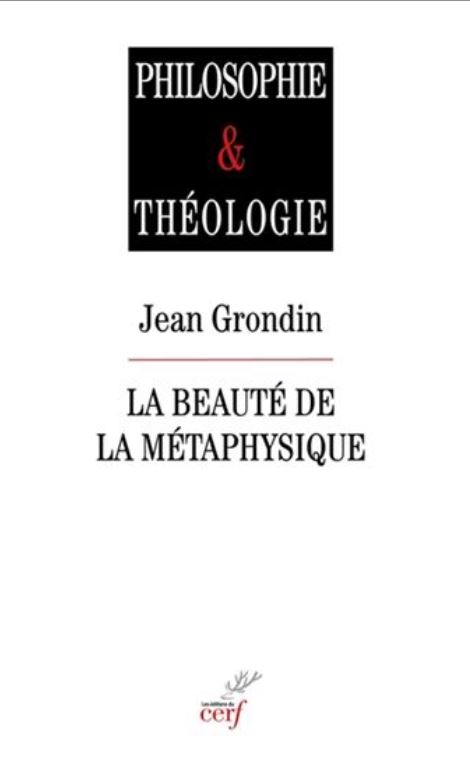The search for wisdom, which is philosophy, is born from metaphysics

The book is in French, but I hope that its main ideas, which I will humbly try to report in English in this summary, will provide some food for thought for us all.
It is true that the word “metaphysics” is frightening. But after having carefully read The Beauty of Metaphysics by philosopher Jean Grondin, I could humbly argue that visual artists are by nature metaphysicians. The author defines metaphysics as the “vigilant effort of human thought [to] understand the whole of reality and its reasons”? (p. 21). “There is metaphysics in everything we do,” he goes on. That said, in front of the work of art in progress, does the artist become a metaphysician when he makes a sustained effort of reflection (conscious or unconscious) to compose his reality on canvas, while relying on shape, color, and reason?
Grondin breaks down the mysterious meaning of the word, and I believe that this is the great quality of the book. There is an “unconscious” metaphysics […] a way that determines our actions and the way we approach things”, as there is a “conscious” one […] that is developed for its own sake and that becomes its own. Since the advent of History, there has always been metaphysics: the Greek, the medieval, the rational, the modern. Each of these metaphysics answers to the other. The metaphysics of Plotinus responds to that of the Stoics, as that of Spinoza responds to that of Descartes, etc. (p. 80). Metaphysics is a deep reflection on things.
I return to visual art, especially to the matter of the intelligible aspect of painting: doesn’t Monet’s thought meet that of Turner, Picasso’s to Cézanne? Doesn’t Monet’s thought respond to Turner’s, Picasso’s to Cézanne’s? Shouldn’t we feed our own work of art from a greater one, which has withstood the test of time? Would metaphysics be evolutive? Would my current work necessarily prevail over the one of yesteryear?
As an archaeologist, Jean Grondin is not afraid to passionately excavate his beloved metaphysics. He identifies three main pillars (ontological, theological, and anthropological) in order to uncover beauty, which is its foundation (p. 45). I believe that this chapter must be carefully read, for it can indicate possible avenues towards the creation of contemporary art, which sometimes lacks a bit of glow, of “resplendent” (in Greek, ekphnestaton, let’s remember the word). Harmony, measure, goodness, finality, intelligence, and meaning (sens) are the roots that wrap the stylobate of Beauty, just as the ivy runs over the ruins of ancient Greek temples. Metaphysics is only beauty.
Grondin goes on to say that “evil” is the opposite of beauty (p. 93). In this respect, he comes close to François Cheng (Five Meditations on Beauty). “What can metaphysics say about it?” (p. 93). Evil is, according to him, an “antimetaphysics” interrupting all reflection. We see this clearly in the news media. Jean Grondin puts forward four or five ideas related to this question of “evil”: recognition of evil, absence of ekphnestaton, disorder, protest, and another idea to which I fully subscribe: “Human beings moan too much” (pp. 102–103); is continuously complaining the only position one can take facing this precious life given to us. Grondin prefers to take action either on a small or large level, which improves our lives, rather than listening to “those who moan [with full bellies] about [their] desolation”. I am thinking here of the “trolls” of social networks, who only contribute to eliminating beauty in all its forms.
I could go on with Grondin’s ideas on “hermeneutics”, another scary word, which simply means “the art of understanding”. But this post is already too long. I must conclude in writing that Grondin often refers to his mentor, the philosopher G. Gadamer, who says (in my much simpler words) that metaphysics is like the search for the experience of truth within itself. Finally, would the metaphysical experience not be the result of lived and changing experiences caused by the search for meaning, of all the elements that make up this moment of confrontation with oneself, facing our art in Italy or Provence?


Jai lu. Compris. Tres bonne interpretation. Thanks
Yves,
Very evocative post. Very simply, we are the sum of our parts. When I paint quickly, I often wonder where the process comes from. How did I know to do that? Why did I do that? I don’t think of my work as being metaphysical, like the surrealists, or Beverly Crawford, or even Janet’s.
It is all about the difference between substance and attribute?
I have read your post several times, and will read it again. Much to consider………..
Tamia
Great post, Yves. For me I find many media more “metaphysical” than painting. For example, I contemplated Godamer’s horizon of understanding while working in video, and I find the process of printmaking meditative and ideally suited to contemplating first principles.
Wonderful post – I agree with all your written statements above especially “metaphysics is like the search for the experience of truth within itself.” but I do think it is the looking for that truth within. Though it is the sum, I have arrived at thus far in my expression of art in hopes that my expression is interpreted at the least subconsciously to everyone who views my art.
Lots to think about….Thanks Yves, great article, have to read it again….
Thank you Yves, simply explained about a difficult subject and given me a lot to ponder on…. Denise